1945/1947 - The Anglo American Istra
The allies liberated Istra in May 1945. During 2 years, the city of Pula and the region of Trieste were under anglo-american administration and the rest of Istra under Yugoslavian administration. Italy ceded the peninsula Istra to Yugoslavia with the Treaty of Paris signed on February 10, 1947 and put in force on September 15, then was integrated into the republic of Croatia under Yugoslavia. Northern Istria was put under the protection of Security Council of UNO under the name of "Free Territory of Trieste". Trieste and the coastline between Duino and Albaro Vescova formed Trieste zone A administrated by the allies, and Trieste zone B administrated by Yugoslavia.
![]() 1945 -
Provisional first series
1945 -
Provisional first series ![]()
As a measure of the liberation of the region, the Italian stamps stocked in the post office were overprinted in name of the province liberated “Istra” and in a new value.
 Italian stamps of 1944 and airmail stamps of 1932 |
stamp of 1942 represents the roman emperor Julius Cesar, and airmail postal stamps of 1930-32 overprinted 0.5 to 2 lires. |
Stamps of the Italian Social Republic overprinted with 0.1 to 2 lires. They cover the diverse subjects: Church Saint-Cyriaque d’Ancone, Basilica San=Lorenzo in Rome, King Victor Emmanuel III, facist allegory, military drummer and the abbey of Mount Cassin. |
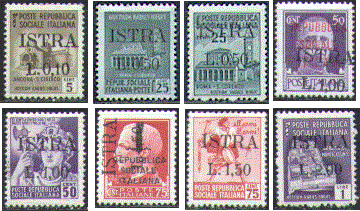 Stamps of Italian Social Republic from 1944/45 |
First series stamps of Istria burdened by the cost of 4 to 20 lires. They represent these diverse subjects: Jules Cesar, military drummer, church Saint-Cyriaqui of Ancone and the King Victor-Enmmanuel III. |
 Istrian Stamps of 1945 overprinted with new denominations |
![]() 1945 - Rijeka - 2nd temporary series
1945 - Rijeka - 2nd temporary series ![]()
This seconde temporary series is issuesd for commemorating the liberation of Rijeka by Tito's partisan troops in May 3, 1945. These where the stamps of the Italian Social Republic that was to be utilised for being overprinted.
 Stamps of the Italian Social Republic of 1944-45 |
Italian Social Republic surchages of 2 to 20 lires. They represent the diverse subjects: Roman Basilica San-Lorenzo, Mount Cassin Abbey, military drummer and the Palermo cathedral. |
|
 |
 |
|
| Print of the overprint on back of offset | ||
![]() 1945-46 - Slovenian coast - common series
1945-46 - Slovenian coast - common series![]()
The only common series that made issue during the allied occupation of Istria continue the principal activity of the region and some important sites of the peninsula.
There were 3 prints of this series:
Ljubljana issue : 10 values perforated 101/2 x 111/2
|
Zagreb issue: 10 values perforated 12;
|
Belgrade issue : 4 values perforated 111/2
|
The stamp subjects were varied.
The agriculture and the peach in Istria, viticulture, peach, olive, ploughing, tuna, donkey,.... |
The population of Istria is composed of a majority of farmers whose most important cultures are the wine, olives and peaches, but equally the wheat, corn, ... in the fertile plains of the west and south east coast. |
farming |
Viticulture (grape growing) |
| The
house of Duino: |
The house of Vladimir Gortan, in Béram: Beram is a small village of 200 habitants (1972) situated in the centre of Istria, north west of Pazin. Beram is protected by a wall and a square tower of average age. The site most interesting in Beram is situated in the cemetery: It surrounds the church Saint Marie, that contains a number of frescos (1474) by the artist Vincenzo de Casua and his sons. The most most famous frescos were "la Danse Macabre", "l'Adoration des Mages" and "la roue dela fortune" ("the ghastly dance", "the adoration of wise men", and "the route of fortune"). The
house in which Vladimir Gortan (anti-facist fighter, executed by the
Italian Facists in 1929) was born, contains a little memorial. |
The bridge of Solkan, on the Soca: Solkan is a little village very known in Slovenija and in the region, at the frontier entering Italy and Slovenija, in the Goriska plains, crossing by the Soca river which empties into the Adriatic after having to clearing a canyon path among Sabotin and Skalnica. This viaduct path of iron is a symbol of the village.
|
Pula Harbour, the amphitheatre and Church of the Virgin of the Ocean: According
to legend of the 'Fleece of Gold', the people of Colchide pursued the
Argonauts in order to recapture the Fleece. But after the demise of the
King's son, they abandoned their pursuit. Expecting that he had to be
punished for the death of the prince and for not having been able to
recover the Fleece of Gold, he decided to exile himself at the same place
where his son died. On the stamp back, back of the ship, Roman Amphitheatre at left and the church of the Virgin of the Sea at right. The
church of the Vigin of the Sea was constructed at the end of the Austrian
period and was consacrated in 1898. It is a neo-bizatin building, with a
number of different styles. The
amphitheatre is a most important monument in Pula. It was constructed in
the 1st century during the reign of empereur Vespasien, at the same time
as the Colleseum in Rome. According to popular legend, Vespasien had
mistress named, Anonia Cenida, that was born in Pula. |
La cathédrale Saint Just de Trieste:
Il y eut un timbre de cette série courante qui fut non émis, car représentant Trieste, qui ne fut pas mis sous le contrôle de Belgrade. Il existe plusieurs essais de couleur de ce timbre, en l'occurrence rouge et marron.
Entre
le 9ème et le 11ème siècle, furent bâties2 basiliques sur les
ruines de l'ancienne, l'une dédiée à la Vierge de l'Assomption, et
l'autre à Saint Just, le Saint Patron de Trieste. La superficie de
l'ancien édifice fut considérablement agrandi. Au 14ème siècle, les 2
basiliques furent assemblées, en détruisant une nef de chaque basilique,
et en construisant une façade asymétrique, dominée par une délicate
rosace gothique, aussi ornementé que le nouveau clocher, utilisant les
pierres romanes trouvées sur le site. Parmi les multiples oeuvres historiques que l'on peut trouver dans la cathédrale, figurent dans les absides 2 superbes mosaïques représentant Saint Just et la Vierge de l'Assomption, réalisées par un maître de Venise au 12ème siècle. Sur la place devant l'église, se trouve un autel commémorant la consécration et le reddition de la 3ème armée, représenté par une colonne avec une hallebarde. |
Le palais du Gouverneur à Rijeka (Fiume) :
En 1946, l'administration yougoslave à Rijeka émet une carte postale pré-timbrée d'une valeur de 3 Lires, représentant le palais du gouverneur, qui contient aujourd'hui le musée historique de la marine.
En 1893, Lodovico Batthyany, gouverneur de Rijeka, donna le projet de construction du futur palais à un architecte en vue de Budapest et professeur universitaire, Alajos Hauszmann. Le palais est construit sur une colline face au port, et présente une vue superbe sur la Méditerranée. Il contient un très grand hall au premier étage et des salons très élégants, dont un salon de marbre décoré "fin de siècle". Toute la décoration est conçue pour convenir aux effets de l'autorité puissante du protocole hongrois. Le palais est le témoin de tous les évènements de la riche histoire de Rijeka, jusqu'au 3 mai 1955, où il devint le siège du musée maritime et historique.
card with stamps of the first series with postmark of 30/11/1946 |
The 3 successive series of postage due on some stamps of the common touristic series overprinted "Porto" and a new value.
First series 1945 -1946
Tuna, raisins and donkey on a harbour overprinted at .5 lira to 20 lires |
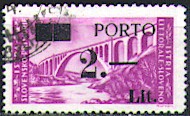 "2" droit
|
There exists a variety in overprint for the 2 Lira stamp representing the Salkan bridge: at left, the normal digit "2", straight foot, and at the right, the fake digit "2", with a rounded foot. |
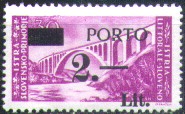 "2" rounded
|
The Solkan bridge front…. |
...back. |
2nde series 1946
The bridge of Solkan overprinted at 10 to 30 lires. |
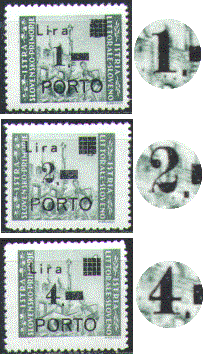 |
There exists two different varieties of overprint on the stamps valued at 1 to 4 lires representing a village in ruin: the point following the digit is square (at left), round (at right-very rare). The forme (location) of the digits is equally different. |
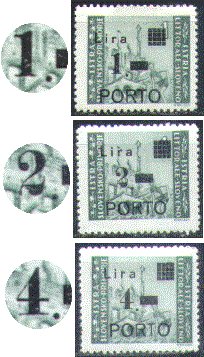 |
Third series 1946
The raisin and the tuna overprinted on 1 to 30 lires. |
![]() 1947 -
Yugoslavian Military Administration
1947 -
Yugoslavian Military Administration ![]()
During 1947, the Allied command decided to tie Istra to Yugoslavia, the yugoslavian army cane in the possession of the territory ane issued a a stamp, in awaiting the official integration into the Federal Republic.
Stamps for postal use
Stamp of 1945 of Yugoslavia represents a Partisan during an assault. Overprinted at 1 to 35 lires. |
Stamps for the use of administration - Official stamps
Official Stamp in 1946 in Yugoslavia represents the emblem of the Republic. Overprinted 1 to 50 lires. |
Postage Due stamps
Postage due in 1946-1947 in Yugoslavia represent the armour of the Republic. Overprinted 1 to 30 lires. |